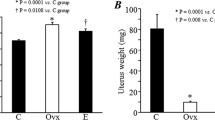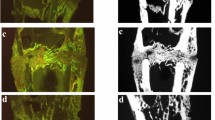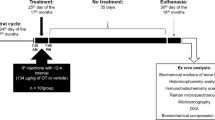Summary
In the mouse, the anabolic effect of estrogen on the uterus and its stimulatory effect on endosteal bone formation are well documented. When these observations are coupled with the recent description of uterine-derived bone cell mitogens, it raises the possibility that uterine hypertrophy in response to estrogen might lead to the production and release of factors that participate in the skeleton's anabolic response to estrogen. To determine if the stimulatory effects of estrogen on endosteal bone formation and uterine tissue in the mouse are related, we have studied this specific skeletal response to ovariectomy (OVX) and ovariohysterectomy (OHTX), and to two levels of 17β-estradiol (17β-E2). To assess treatment effects, 48 Swiss-webster mice were assigned to six groups: OHTX/oil vehicle, OVX/oil vehicle, OHTX/150 μg 17β-E2, OHTX/300 μg 17β-E2, OVX/150 μg 17β-E2, and OVX/300 μg 17β-E2. Animals were treated once per week with vehicle or the respective 17β-E2 dose. To quantitate bone formation, fluorochrome labels were administered at the beginning and end of the experimental period. At the conclusion of the 5-week study, tibiae were processed undecalcified for embedding in methyl methacrylate plastic. Cross-sectional areal properties and bone formation rates were quantitated from 30 μm mid-diaphyseal sections using a Bioquant Bone Morphometry system. Compared with the vehicle-treated OVX and OHTX mice, 150 μg of 17β-E2 administered once per week significantly increased cortical bone areas (P<0.05) but cortical bone widths and the ratio of cortical bone area to total bone area was increased only in estrogen-treated OVX mice (P<0.01). The attenuation of bone formation in the OHTX mice was even more apparent in animals treated with 300 μg 17β-E2. Endosteal mineral apposition and bone formation, cortical bone widths, and cortical bone ratios were all significantly reduced in OHTX mice compared with OVX animals treated with the same 17β-E2 dose. Indeed, the 17β-E2-induced cortical bone increases in the OVX animals were reduced 50% by OHTX. These results suggest that the anabolic effects of high-dose 17β-E2 on endosteal bone formation in the mouse are modulated by estrogen's uterotrophic activity, and are therefore consistent with the hypothesis that the uterus may produce and release factors with the capacity to stimulate bone formation.
Similar content being viewed by others
References
Lopez A, Ventanas J, Burgos J (1986) Oestradiol and testosterone binding sites in mice tibiae and their relationship with bone growth. Exp Clin Endocrinol 88:31–38
Ericksen E, Colvard D, Berg N, Graham M, Mann K, Spelsberg T, Riggs L (1988) Evidence of estrogen receptors in normal human osteoblast-like cells. Science 241:84–86
Komm B, Terpening C, Benz D, Graeme K, Gallegos A, Dorc M, Greene G, O'Malley B, Haussler M (1988) Estrogen binding, receptor mRNA, and biologic response in osteoblast-like osteosarcoma cells. Science 241:81–84
Ernst M, Schmid C, Froesh E (1988) Enhanced osteoblast proliferation and collagen gene expression by estradiol. Proc Natl Acad Sci USA 85:2307–2310
Ernst M, Heath J, Rodan G (1989) Estradiol effects on proliferation, mRNA for collagen and IGF-1, and PTH-stimulated adenylate cyclase activity in osteoblastic cells from calvariae and long bones. Endocrinology 125:825–833
Gray T, Mohan S, Linkhart T, Baylink D (1989) Estradiol stimulates the secretion of insulin-like growth factors by the clonal osteoblastic cell, UMR 106. Biochem Biophys Res Commun 158:407–412
Takano-Yamamoto T, Rodan G (1990) Direct effects of 17β-estradiol on trabecular bone in ovariectomized rats. Proc Natl Acad Sci USA 87:2172–2176
Hreshchyshyn M, Hopkins A, Zylstra S, Anbar M (1988) Effects of natural menopause, hysterectomy, and oophorectomy on lumbar spine and femoral neck bone densities. Obstet Gynecol 72(4):631–638
Koutsilieris M (1989) Human uterus-derived growth substances for rat bone cells and fibroblasts. Am J Obstet Gynecol 161(5): 1313–1317
Murphy LJ, Murphy LC, Friesen H (1987) Estrogen induces insulin-like growth factor-1 expression in the rat uterus. Mol Endocrinol 1:445–450
Carlsson B, Billig H (1991) Insulin-like growth factor-1 gene expression during development and estrous cycle in the rat uterus. Mol Cell Endocrinol 77:175–180
Canalis E (1980) Effect of insulin-like growth 1 on DNA and protein synthesis in cultured rat calvaria. J Clin Invest 66:709–719
Schmid C, Steiner R, Froesch E (1983) Insulin-like growth factors stimulate synthesis of nucleic acids and glycogen in cultured calvaria cells. Calcif Tissue Int 35:578–585
Howard G, Spencer E (1984) Endocrine control of bone and calcium metabolism. In: Cohn D, Fujita T, Potts J Jr, Talmage R (eds) Excerpta Medica, Vol. 1. Elsevier, Amsterdam, pp 86–89
Spencer E, Liu C, Howard G (1991) In vivo actions of insulin-like growth factor (IGF-1) on bone formation and resorption in rats. Bone 12:21–26
Urist M, Budy A, McClean F (1950) Endosteal bone formation in estrogen-treated mice. J Bone Jt Surg 32(A):146-146-162
Liu C, Howard G (1991) Bone cell changes in estrogen-induced bone mass increase in mice: dissociation of osteoclasts from bone surfaces. Anat Rec 229:240–250
Edwards M, Bain S, Bailey M, Lantry M, Howard G (in press) 17β Estradiol stimulation of bone formation in the ovariectomized mouse: an animal model for the evaluation of bone-targeted estrogens. Bone
Bain S, Impeduglia T, Rubin C (1990) Cement line staining in undecalcified thin sections of cortical bone. Stain Tech 65(4): 159–163
Turner R, Wakley G, Hannon K, Bell N (1987) Tamoxifen prevents the skeletal effects of ovarian hormone deficiency in rats. J Bone Miner Res 2(5):449–456
Steel R, Torrie J (1980) Principles and procedures of statistics: a biometrical approach, 2nd ed. McGraw-Hill, New York
Brigstock D, Heap R, Brown K (1989) Polypeptide growth factors in uterine tissues and secretions. J Reprod Fert 85:747–758
Liu C, Richardson G (1991) Estrogen increases skeletal and hepatic IGF-1 gene expression in mice. J Bone Miner Res 6(Suppl 1):S210
Frost H (1980) Skeletal physiology and bone remodeling: an overview. In: Urist M (ed) Fundamental and clinical bone physiology. J B Lippincott, Philadelphia, pp 208–241
Jaworski Z (1976) Bone envelope specific remodeling behavior. In: Jaworski Z (ed) Proc 1st workshop on bone morphometry. University of Ottawa Press, Ottawa, pp 254–256
Bain S, Bailey M, Edwards M (1991) Inhibition of bone resorption in the ovariectomized mouse: dose-dependence and site-specificity of estrogen action. J Bone Miner Res 6(suppl 1):S215
Spies H, Hilliard J, Sawyer C (1968) Pituitary and uterine factors controlling regression of corpora lutea in intact and hypophysectomized rabbits. Endocrinology 89:291–299
Biro J (1980) Regulation of pituitary nucleic acid metabolism in female rats. J Steroid Biochem 12:351–354
Biro J, Ritzen M, Eneroth P (1987) Effects of hysterectomy and uterine extracts on the gonadotrophic hormones and the weight of endocrine organs of female rats. Exp Clin Endocrinol 89 (1):23–30
Burch J, Byrd B, Vaughn W (1974) The effects of long-term estrogen on hysterectomized women. Am J Obstet Gynecol 118(6):778–782
Author information
Authors and Affiliations
Rights and permissions
About this article
Cite this article
Bain, S.D., Bailey, M.C. & Edwards, M.W. The anabolic effect of estrogen on endosteal bone formation in the mouse is attenuated by ovariohysterectomy: A role for the uterus in the skeletal response to estrogen?. Calcif Tissue Int 51, 223–228 (1992). https://doi.org/10.1007/BF00334551
Received:
Revised:
Issue Date:
DOI: https://doi.org/10.1007/BF00334551




